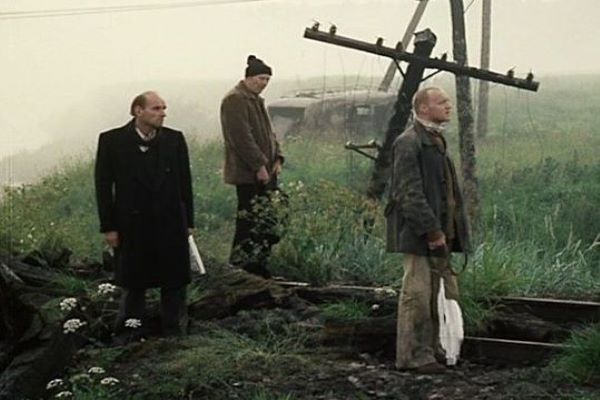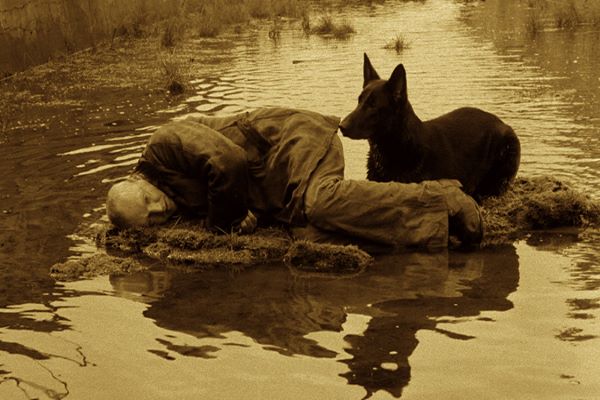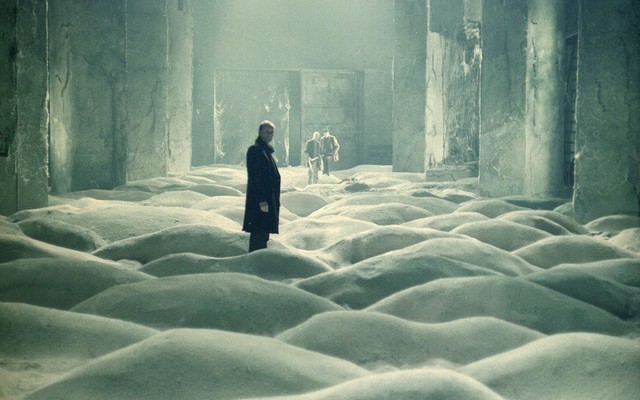Andrei Tarkovsky’s immensely philosophical film Stalker digs deeper into human souls and tries to find out the true meaning of life. Humans exist in this world with an array of desires without knowing the innermost one. They chase dreams and fantasies forgetting their near and dear ones. However, without knowing the basic purpose of life, they get encircled and trapped again and again. They lose hope and life seems to be futile and worthless. Tarkovsky’s deeply soul-searching film Stalker portrays the helplessness and suffering of humans who have lost their self-respect. Their identities have been severely crushed by their disbelief. The film vividly points out the spiritual crisis of humans in the modern world. It also shows that the only way of redemption is through love. No matter how badly we are shattered and torn apart, the only way forward is through basic human emotions like love, compassion, happiness, and togetherness.
Even though the basic setup of the film looks like science fiction, it is mostly a philosophical and psychological film with metaphysical elements. The story of the film is centered around a Zone, which is full of extraterrestrial elements and devoid of the basic principles of physics. There is a Room inside the Zone where the innermost desires of humans get fulfilled. The Zone is strictly guarded by government forces. A Stalker (Alexander Kaidanovsky), who takes visitors through the Zone, leaves his wife and daughter at home to take his two new clients, a Writer (Anatoly Solonitsyn) and a Professor (Nikolai Grinko), to the Zone. They evade the blockade following a military train and reach the center of the Zone by a railway work car. The Stalker tells his clients to follow his instructions strictly. He also says that the Zone is full of traps and must be respected. The straitest path is not always the shortest path. The Stalker keeps throwing a metal nut tied to cloth to check if there is any trap inside the Zone. He narrates the story of the previous stalker Porcupine who successfully entered the Room but committed suicide when he became wealthy but could not save his brother. As they proceed through the Zone, they discuss their objectives for this journey to the Room. The Writer says that he lacks inspiration and wants to regain it. The professor wants to research the Zone and win the Nobel Prize. The Stalker says that his only objective is to get his clients’ desires fulfilled.

After crossing multiple tunnels, they finally reach their destination – the Room. However, neither the Writer nor the Professor is ready to enter it. The Professor now reveals his true intention that he wants to destroy the Room to stop its usage for evil purposes. He has brought a twenty kiloton bomb with him and is all set to carry out his mission. All three engage in a scuffle outside the Room. The Writer realizes that nobody in the world surely knows their innermost desire. So, the Room can never be used for selfish purposes. The same situation happened for Porcupine as well. When he could not save his brother, he increasingly felt guilt-ridden and committed suicide. The professor abandons his original plan, dismantles the bomb, and scatters its pieces nearby. The trio returns to the bar again without accomplishing their mission. The Stalker tells his wife that nobody has the faith to enter the Room. Their differently-abled daughter Martyshka pulls three glasses using her Psychokinetic abilities while a train passes by.
Stalker vividly shows how painful a spiritual crisis is. When humans lose self-belief and self-esteem, the suffering is enormous. They tend to overlook happiness and satisfaction within themselves and chase those in an unknown world. It looks similar to chasing a mirage in an oasis. In the end, neither the Writer nor the Professor has the courage to enter the room. The Writer clarifies that nobody in this world is aware of their innermost desire. A desire that is deemed innermost may not be the same. So, humans lack the confidence and courage to face the reality. Porcupine was not aware that his innermost desire was to be wealthy. So, when he tried to save his brother, his desire was not granted. The film largely points out the shallowness of human lives. Nobody is happy because they are not content within themselves. Selfish motives always bring a vacuum to the soul. Life is filled with both happiness and grief, anger and peace, gain and loss. One cannot expect only positives and wipe out the negatives. The world is full of good and bad, holy and evil.
In the last scene of the film, the Stalker’s differently-abled daughter sits on a chair and moves three glasses kept in the adjacent table by psychokinetic forces. The empty glass falls off the table. However, almost immediately, a train passes by the house. It astonishes the viewers whether her psychokinetic capability or the vibration of the train moves the glasses. Out of three glasses, only the empty one falls off the table. Does Tarkovsky refer to the vulnerability of humans suffering from the spiritual crisis? Viewers can only guess but do not know the answer. Stalker is not a symbolic film, but it highlights the power of the symbols and how those affect us and we try to make sense of the universe and ourselves based upon those.

The selfless action of the protagonist of the film can be compared to the works of an artist. Despite being fully aware of the hazardous situation of the Zone, The Stalker takes his clients through the Zone to get their desires to come true. The film depicts his sacrifices for others. In the same way, an artist always tries to find out the true meaning of life and presents it to the world through their works. The basic objective of an artist is to live for the world and not just for himself. In spite of numerous obstacles, an artist is not afraid of exposing evil and showing the pathway of an ideal life.
Stalker is a continuous film almost without any time-lapse. Tarkovsky wanted time and its passing to be revealed in each frame. He did not want any jump or manipulation of time so that the entire film looks like a single shot. With the continuity of time, he wanted to portray that cinema can very well observe life and that is the true essence of poetic cinema. There is no surprise that the entire film has only 142 shots.
Through Stalker, Tarkovsky wanted to clearly indicate the supreme value of love by which humans live. He wanted to portray that love alone is proof against the misconception that there is no hope in this world. However, humans can no longer spread the purest form of love. The Writer lacks inspiration for his creativity and for that reason, he visits the Zone to know the unknown and recognize the unrecognized. He wants to be astonished and shaken by the miracles at the Zone. However, he gets astonished to see that Stalker’s wife still holds the same level of selfless and unconditional love and devotion for his husband as before. Instead of the Zone, the faithfulness and human dignity of a simple woman startle him. As an artist, Tarkovsky vividly shows that the supreme factor which determines the meaning of a person’s life is his capacity to love. When he is fortunate enough to have all the worldly blessings, he is too busy chasing the mirage. The Zone does not mean anything. Our fates lie in our hands. Whether humans will be able to find out love, compassion, happiness, and other basic emotions, depends on themselves.
The screenplay of the film is written by Arkady and Boris Strugatsky based on their 1972 novel Roadside Picnic. However, apart from the basic science fiction setup, the film is largely different from the novel with multiple alterations by Tarkovsky himself. Stalker features Tarkovsky’s signature styles like long takes, slow and subtle camera movement, and multiple wide-angle long shots. As usual, he uses water in multiple scenes in this film as well. Stalker is divided into two colors. All the scenes outside the Zone are in sepia and the scenes inside the Zone are in normal color. Tarkovsky probably wanted to portray the delusion of the Zone through the colorful images. Tarkovsky shot the entire film with Georgy Rerberg as the cinematographer. However, he had to reshoot the entire film as the footage was improperly developed and could not be used. After this incident, Tarkovsky was devastated and fired Rerberg. The film was shot in and around Tallinn, Estonia. It is suspected that Tarkovsky, his wife Larisa, and Anatoly Solonitsyn died of cancer caused by the poisonous liquids from a chemical plant in the shooting location around the Jagala River in Tallinn.
Tarkovsky wanted to mix up music and sound so that their existences can not be differentiated. He even got some sound created artificially by composer Eduard Artemyev on his synthesizer. As per him, music is not a mandatory requirement for films and can be replaced by sound. Beethoven’s Symphony No. 9 is used in the film but it is barely heard amidst surround noises. Tarkovsky wanted a combination of eastern and western music for composing the background score of Stalker. After a series of research, Artemyev finally used a combination of the tunes of flute, tanpura, and Azerbaijani tar. The tunes were moduled significantly to form a single string. Tarkovsky even got some noises created artificially like the sound of the train. Even though Stalker received mixed reactions initially, it is now considered as one of the greatest films ever made.
